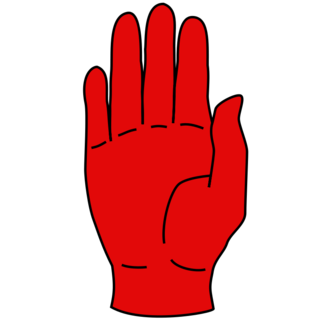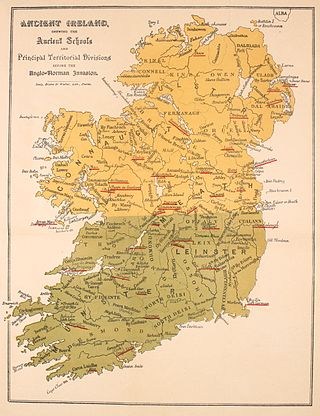Related Research Articles

Lugh or Lug is a figure in Irish mythology. A member of the Tuatha Dé Danann, a group of supernatural beings, Lugh is portrayed as a warrior, a king, a master craftsman and a savior. He is associated with skill and mastery in multiple disciplines, including the arts. Lugh also has associations with oaths, truth and the law, and therefore with rightful kingship. Lugh is linked with the harvest festival of Lughnasadh, which bears his name. His most common epithets are Lámfada and Samildánach.
Conn Cétchathach, or Conn of the Hundred Battles, son of Fedlimid Rechtmar, was a semi-legendary High King of Ireland who is the ancestor of the Connachta, and through his descendant Niall Noígiallach, the Uí Néill dynasties, which dominated Ireland in the early Middle Ages. Additionally, Conn is the progenitor of the Quinn family through his son Art mac Cuinn.

In Irish mythology, Nuada or Nuadu, known by the epithet Airgetlám, was the first king of the Tuatha Dé Danann. He is also called Nechtan, Nuadu Necht and Elcmar, and is the husband of Boann. He is mostly known from the tale in which he loses his arm or hand in battle, and thus his kingship, but regains it after being magically healed by Dian Cécht. Nuada is thought to have been a god and is related to the British and Gaulish god Nodens, who is associated with hunting and fishing. His Welsh equivalent is Nudd or Lludd Llaw Eraint.
Cumhall or Cumhall mac Trénmhoir is a figure in the Fenian Cycle of Irish mythology, a leader of the fianna and the father of Fionn mac Cumhaill.
Cathair Mór, son of Feidhlimidh Fiorurghlas, a descendant of Conchobar Abradruad, was, according to Lebor Gabála Érenn, a High King of Ireland. He took power after the death of Fedlimid Rechtmar. Cathair ruled for three years, at the end of which he was killed by the Luaigne of Tara, led by Conn Cétchathach. The Lebor Gabála Érenn synchronises his reign with that of the Roman emperor Marcus Aurelius (161–180). The chronology of Geoffrey Keating's Foras Feasa ar Éirinn dates his reign to 113–116, that of the Annals of the Four Masters to 119–122.

The early medieval history of Ireland, often referred to as Early Christian Ireland, spans the 5th to 8th centuries, from the gradual emergence out of the protohistoric period to the beginning of the Viking Age. The period includes the Hiberno-Scottish mission of Christianised Ireland to regions of pagan Great Britain and the spread of Irish cultural influence to Continental Europe.

Niall Noígíallach, or Niall of the Nine Hostages, was a legendary, semi-historical Irish king who was the ancestor of the Uí Néill dynasties that dominated Ireland from the 6th to the 10th centuries. Historical Irish annalistic and chronicle sources place his reign in the late 4th and early 5th centuries, although modern scholars date him about half a century later.
Nuadu Necht, son of Sétna Sithbac, a descendant of Crimthann Coscrach, of the Laigin, was, according to medieval Irish legend and historical tradition, a High King of Ireland. He came to power after killing his predecessor, Eterscél, and ruled for six months, at the end of which he was killed by Eterscél's son Conaire Mór.
Lugaid Mac Con, often known simply as Mac Con, was, according to medieval Irish legend and historical tradition, a High King of Ireland. He belonged to the Corcu Loígde, and thus to the Dáirine. His father was Macnia mac Lugdach, and his mother was Sadb ingen Chuinn, daughter of the former High King Conn Cétchathach. Mac Con may be to some extent identical with another legendary King of Tara from the Dáirine, Lugaid Loígde.
Ailill Ollamh in Irish traditional history was the son of Mug Nuadat and was a king of the southern half of Ireland, placed in the 3rd century by early modern Irish genealogy. Sadb ingen Chuinn, daughter of Conn of the Hundred Battles, in her second marriage, married Ailill. He divided the kingdom between his sons Éogan Mór, Cormac Cas, and Cían. Éogan founded the dynasty of the Eóganachta. Sadb's son Lugaid Mac Con, who was Ailill's foster-son, became High King of Ireland.
In Irish traditional history Eógan, eldest son of Ailill Ollamh, was a 2nd or 3rd century AD king of Munster. He ruled for either fifteen or seventeen years, though fifteen is the number most often given. He is credited with founding or at least giving his name to the Eóganachta, a dynasty which ruled as kings of Munster and later princes of Desmond until the late 16th century. He died at the battle of Maige Mucrama at the hands of his stepbrother, Lugaid Mac Con, which story is told in the Cath Maige Mucrama. The son of Eógan Mór was Fiachu Muillethan. His mother was Sadb ingen Chuinn, daughter of Conn of the Hundred Battles.

The Eóganachta or Eoghanachta were an Irish dynasty centred on Cashel which dominated southern Ireland from the 6/7th to the 10th centuries, and following that, in a restricted form, the Kingdom of Desmond, and its offshoot Carbery, to the late 16th century. By tradition the dynasty was founded by Conall Corc but named after his ancestor Éogan, the firstborn son of the semi-mythological 3rd-century king Ailill Aulom. This dynastic clan-name, for it was never in any sense a 'surname,' should more accurately be restricted to those branches of the royal house which descended from Conall Corc, who established Cashel as his royal seat in the late 5th century.

Crimthann Mór, son of Fidach, also written Crimthand Mór, was a semi-mythological king of Munster and High King of Ireland of the 4th century. He gained territory in Britain and Gaul, but died poisoned by his sister Mongfind. It is possible that he was also recognized as king of Scotland. This Crimthann is to be distinguished from two previous High Kings of Ireland of the same name, two Kings of Leinster, and another King of Munster, among others. Importantly, he is included in the Baile Chuinn Chétchathaig (summary), and is thus the last High King of Ireland from Munster until Brian Bóruma, over six hundred years later.

Leath Cuinn and Leath Moga are legendary ancient divisions of Ireland.
Erc was king of Irish Dál Riata from 439 until 474, succeeding Eochaid Muinremuir. He was the father of three sons: Fergus Mór, Loarn and Oengus. He also may have been the great-grandfather of Muirchertach mac Muiredaig. Confusion arises from the latter's matronym, Macc Ercae, said to come from his legendary mother Erc ingen Loarn, daughter of Loarn mac Eirc. She married Muiredach mac Eógain. According to the Duan Albanach and the Senchus Fer n-Alban, Erc of Dál Riata's father was Eochaid Muinremuir, son of Áengus Fert, son of Fedlimid, son of Oengus, son of another Fedlimid, son of Senchormaich, son of Cruitlinde, son of Findfece, son of Archircir, son of Eochaid Antoit, son of Fiacha Cathmail, son of Cairbre Riata, son of Conaire Cóem and Saraid ingen Chuinn.
Éogan or Eógan is an early Irish male name, which also has the hypocoristic and diminutive forms Eoganán, Eóghainin, Eóghain and Eóghainn. In more modern forms of Irish it is written as Eóghan or Eoghan (/'oːəun/).

The Kingdom of Munster was a kingdom of Gaelic Ireland which existed in the south-west of the island from at least the 1st century BC until 1118. According to traditional Irish history found in the Annals of the Four Masters, the kingdom originated as the territory of the Clanna Dedad, an Érainn tribe of Irish Gaels. Some of the early kings were prominent in the Red Branch Cycle such as Cú Roí and Conaire Mór. For a few centuries they were competitors for the High Kingship or Ireland, but ultimately lost out to the Connachta, descendants of Conn Cétchathach. The kingdom had different borders and internal divisions at different times during its history.
Fiachu Muillethan or Fiachu Fer Da Liach, son of Éogan Mór, was a legendary king belonging to the Deirgtine, the proto-historical ancestors of the Eóganachta dynasties of Munster. He is known primarily from the saga Forbhais Droma Dámhgháire, in which he is assisted by the famous Mug Ruith, who repels an invasion of his kingdom by Cormac mac Airt. The sons of Fiachu Muillethan were Ailill Flann Mór and Ailill Flann Bec.
The Mairtine were an important people of late prehistoric Munster, Ireland who by early historical times appear to have completely vanished from the Irish political landscape. They are notable for their former capital, Medón Mairtine, becoming the chief church of the later Eóganachta, namely Emly.
References
- ↑ Dictionary of the Irish Language [ permanent dead link ] entry for mug
- ↑ O'Rahilly, T.F. Early Irish History and Mythology (1946) p490
- ↑ Irish pedigrees; or, The origin and stem of the Irish nation (1892), by John O'Hart, - Volume: 1, pg.67